The 4 C's of Diamonds
What’s IMPORTANT When Buying Diamonds?
- Home /
- Diamond Education /
- The 4 C's of Diamonds
So the time has come and you want to buy a diamond and you hear about these "mystical" 4 C's of Diamonds in every corner…? While most diamonds might look quite similar, there are small factors and attributes that differentiate them one from the other. And, these "small" factors and differences make each of them special but more importantly to you - very different in value.
But how can diamonds be compared? How can you evaluate them? Who will evaluate them? This is exactly the reason why a diamond grading system and methodology was invented and Gemological Institutes were created.
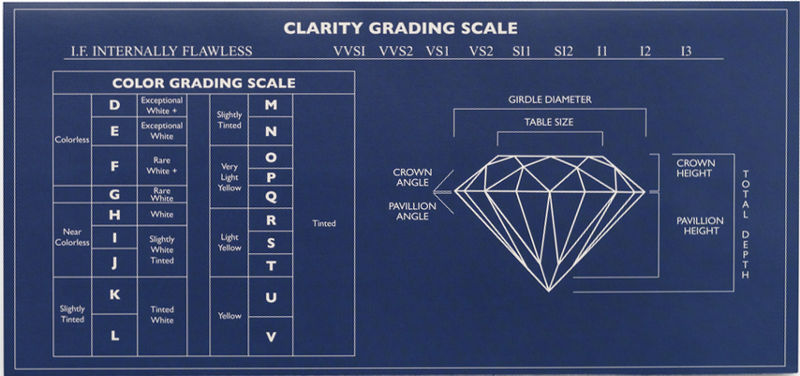 Diamond Grading
Diamond Grading
For a quick 5 minute exaplanation of the 4 C's of diamonds, take a look on this newly created video:
- What Are the Gemological Institutes?
- The 4 C's of Diamonds - Standardizing Diamond Grading
- GIA Explanation of the 4C's [Video]
- What Are The 4 C's of Diamonds?
- 4 C's Diamond Charts
- Which of the 4 C's of Diamonds is Most Important?
- What is the Best Grade for a Diamond?
What Are the Gemological Institutes?
The gemological institutes are objective diamond graders (some even non-profit) that determine the attributes of diamonds (and gems). Their job is to be the judge and jury of each diamond - a responsible adult if you will. After all, when the price of a diamond is so high, would you trust the scale of the seller to determine the weight? Do you trust his expertise to determine its quality?
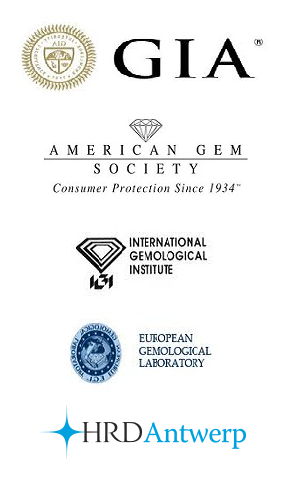 Gemological Institutes
Gemological Institutes
Over the years more and more such gemological institutes were established. The most commonly known to date are:
- GIA - Gemological Institute of America
- AGS - American Gem Society
- IGI - International Gemological Institute
- EGL - European Gemological Laboratory
- HRD - Hoge Raad voor Diamant
But a new problem was born, what diamond attributes to measure? Who is the authority grader that his word matters the most? And maybe the most important, what is the meaning behind all of these diamond grades?
The 4 C's of Diamonds - Standardizing Diamond Grading
With the prices of diamonds constantly increasing and some surpassing the price of a small car (in some occasions the price of a not so small house) every small change means a lot of money for the consumers. In 1953 the GIA established a system that later became the universal standard for grading diamonds - The 4 Cs of Diamonds. The purpose of the system was to create a unanimous way, a universal language for everybody around the globe to be able to communicate when it comes to describe the quality and attributes of diamond.
It worked.
The success of this "new system" was clear and two years later (1955) the GIA presented the diamond certificates that documented each diamond's four C's.
Before drilling deeper into the 4 Cs of diamonds, here is a great video by the GIA which I highly recommend seeing (4 minutes):
What Are The 4 C's of Diamonds?
The diamond's 4 C's are: Color, Cut, Clarity and Carat Weight. Using these four attributes you can grasp the quality of a diamond and its beauty as well as compare all diamonds against each other. As the GIA puts it:
"the key to understanding a diamond and its value is to understand the four attributes that all diamonds share: color, clarity, cut and carat weight"
Each of these four quality factors (as well as a few others) is carefully examined and evaluated on its own and put on a scale, a chart that shows how it's doing.
-
Diamond Cut -
Unlike what most people think of when talking about a diamond's cut - it does not refer to the diamond's shape but rather to the quality of the diamond's "make" for a given shape. Is the number of facets correct? How are they aligned one compared to the other? What about the size of the facets? Is it shallow or deep? Is a round diamond perfectly rounded?
Recommended Reading: Diamond Cuts and Shapes (opens in a new window)
At the end of the day, the answers behind these questions (and more) reflect on how the diamond will… reflect. How the light will bounce off of it and how much brilliance and sparkle it will have. The grades that are given are on the scale of Fair, Good, Very Good and Excellent and are given for polish, symmetry and cut (fancy shapes don't have a cut score).
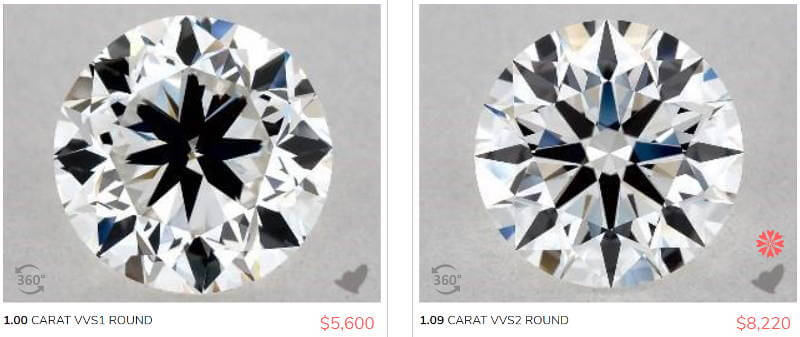 Diamond Cut Comparison - Good Cut vs Excellent Cut
Diamond Cut Comparison - Good Cut vs Excellent Cut
(image credit: JamesAllen.com)Cut Buying Tip:
The increments in pricing when improving diamond cut are negligible in compare to what you are getting. I would recommend buying a diamond with an Excellent cut grade
-
Diamond Color -
Ironically, when speaking of grading a diamond for its color the meaning is actually the diamond's lack of color (unless speaking on fancy colored diamonds). Colors are graded on a scale of D – Z (alphabetical). D being the purest and most lucid color, completely colorless. As you go down the alphabet the diamond gets a slight tone of color, yellow or brown.
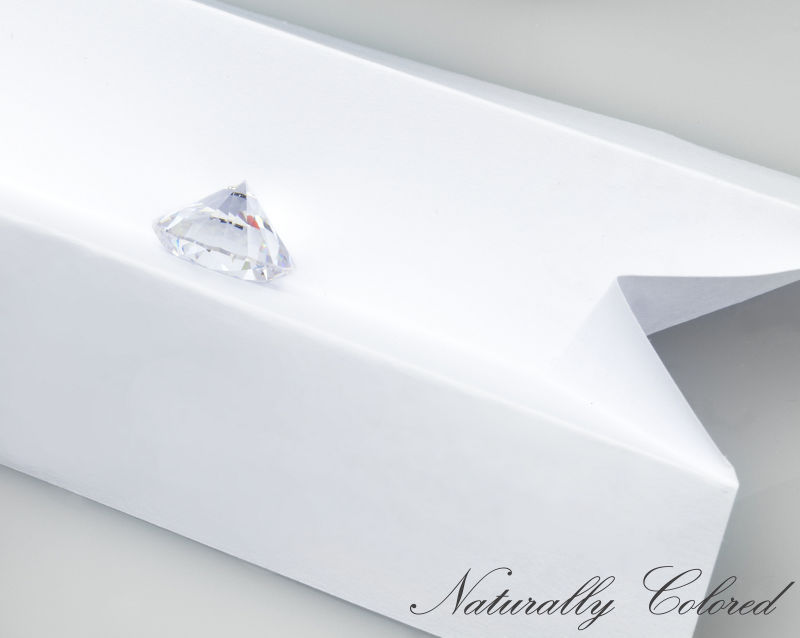 Grading Color using Color Paper
Grading Color using Color Paper
Color Buying Tip:
G color is considered to be the best value for money diamond color. And if you are mounting the diamond in a yellow gold setting and looking to save further - you can go down one more color grade to H.
-
Diamond Clarity -
Diamond clarity grade refers to the appearance of inclusions within the diamond or on it. The clarity chart goes as follows: FL, IF, VVS1, VVS2, VS1, VS2, SI1, SI2, I1, I2. Some gemological laboratories also include SI3 and I3 grading.
Clarity Buying Tip:
While each diamond needs to be inspected for its own, an SI1 clarity diamond is considered to be an eye clean diamond - meaning a diamond with inclusion that you won’t see without magnification. Why pay to remove things you cannot see?
-
Diamond Carat -
Diamond's carat refers to its weight. Note that while usually higher weight refers to a bigger diamond it doesn't have to be the case - the way a diamond is cut has effect on it. Weight is very important when it comes to pricing of diamonds since diamonds are priced per carat and there are lots of tricks on how to manipulate it on your behalf and save a lot of money...
Carat Buying Tip:
Staying below weight classes will save you a lot of money. If you were looking to buy a 1 carat diamond, consider 0.95 carat, instead of a 2 carat diamond, consider 1.90 carat and so on.
But these grades are far from being enough.
4 C's Diamond Charts
It wasn't until 2007 that the GIA took the diamond grading one step further. Up till then, the certificates were a bunch of number, symbols and angles presenting the diamond anatomy. While at this stage GIA had accomplished its goal of creating a universal language for diamond grading, the fact was that a person wanting to buy a diamond still couldn't use the certificate for his main purpose - a tool to help with the process of choosing a diamond. After all, can you understand from the diamond's chart on the right what is the cut quality of the spoken diamond?
Today, in order to simplify the gemological repot, there are obvious diamond quality & grading charts for the 4 C's that everybody can relate with and easily understand. All you need to do is to take the value from the certificate and place it on the scale. Here are the the ones you can find on the GIA's certificate:
- Diamond Color Chart
- Diamond Clarity Chart (along with a sketch)
- Diamond Cut Chart (along with a proportions chart)
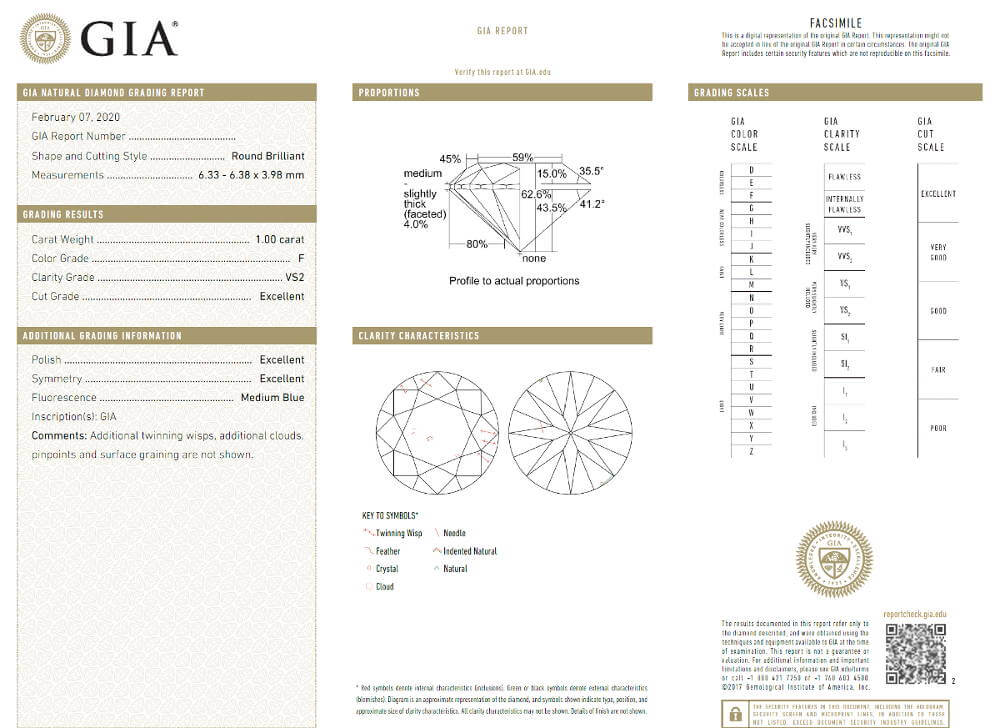 The 4 C's of Diamonds as seen on in a GIA Certificate
The 4 C's of Diamonds as seen on in a GIA Certificate
The last and only C that doesn't get a chart on it's own is the Carat Weight because it is the easiest one for people to understand.
As you can see from the sample certificate, when a diamond is graded, besides for stating its various grades they are also put on the relevant chart in such a manner that you will know exactly how good it is.
Which of the 4 C's of Diamonds is Most Important?
When it comes to evaluating a diamond, the 4 C's live in equilibrium. Generally speaking, moving up the scale in one of the charts above will allow you to move down one scale in the other chart and stay with diamonds of the same value (roughly).
In other words, a 1.00 carat with G color and SI1 clarity diamond will cost approximately the same as a 1.00 carat diamond with H color and VS2 clarity (one color grade lower and one clarity grade higher).
Recommendation:
Check out our Diamond Price Calculator and see for yourself how the 4 C's affect pricing.
You can obviously also play with a diamond weight, reduce the carat weight on one hand and increase the clarity / color grades and stay in the same price level – in other words – quantity or quality.
But a diamond's cut is somewhat different.
An ideal cut diamond, a triple Ex diamond, will have some premium to its price compared to a very good cut grade but not a lot. And everybody wants a diamond to sparkle. An attribute that is very noticeable in every size or color of a diamond. And what good is a high clarity diamond or pure colorless diamond if it is dull? After all, people are buying diamonds for their shine… for their sparkle!
This is why most diamanters would classify the importance of the 4 C’s as follows:
- Diamond Cut
- Diamond Color
- Diamond Clarity
- Diamond Carat Weight
What is the Best Grade for a Diamond?
The answer to the question of what is the best grade diamond is a D color diamond with Flawless clarity and Excellent cut at the weight that you desire. There are additional attributes to consider such as no fluorescence but when it comes to the 4 C's this is it.
But that is the "ideal diamond", the most expensive diamond there is. A "perfect" diamond.
Realistically, under a budget, the best grade would be a G color diamond with si1 clarity grade and excellent cut with no fluorescence at a weight of your choice.
last but not least tips:
What are the 5 C's of Diamonds?
I'm often asked what are the five C's of diamonds? Technically speaking, there are no more C's, only four. However, lately, there is another Criteria which people refer to as the Fifth C of Diamond Grading.
The fifth C is sometimes referenced as Certificate and sometimes as Confidence. It doesn't matter which one you follow the intent behind it, the meaning, is the same. Knowing what you are buying or in other words get what you are paying for.
Everybody can issue a certificate specifying the Four C's of a bespoken diamond. But the question is are they qualified and professional enough to do so? (and that assuming they have the integrity to do so). Over the years many reputable jewelry companies issued their own certificate of authenticity as for the diamond's quality and attributes. But those companies have the incentive to lie (or at least to round it up) towards their own sake. A minor "mistake" of grading a diamond color as D instead of E means A LOT of money. Therefore, only trust the objective certificate of a gemological institute and the GIA's certificate is known to be strict non-compromising and accurate. Why settle for anything else?
Looking Beyond the 4C's of Diamond Grading
While diamond grading reports are amazingly helpful and nowadays I do not recommend anyone to buy a diamond without a certificate, at the end of the day, a diamond's appeal also counts. With all the respect for the 4 C's – they make the most of a diamond but not all.
Don't forget to look at the diamond and decide if you like it or not...
